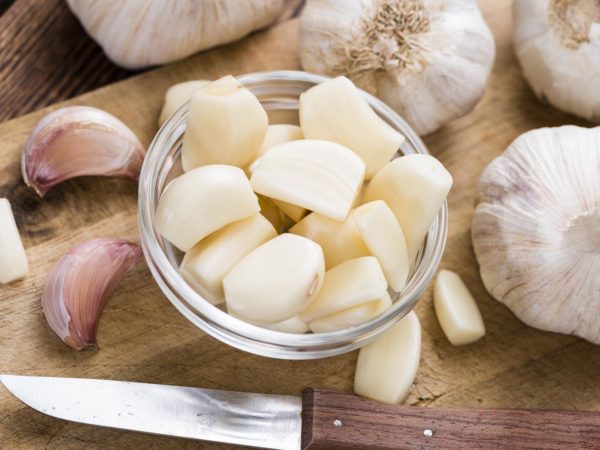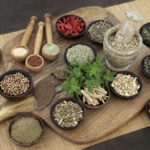Cooking With Spices: Garlic

Garlic (Allium sativum) is one of the oldest cultivated plants in the world, having been grown for over 5,000 years. Native to central Asia, it is a member of the lily family, which includes onions, chives and leeks. Garlic is renowned not just for what it brings to the culinary world, but for its abundant healing properties.
Garlic was used by ancient Egyptians as a sacred offering to be placed in Pharaohs’ tombs. It was given to slaves building the Pyramids for endurance and strength. During the Middle Ages, it was believed to ward off disease, including the Black Death. Migrating cultures introduced garlic to other regions throughout the world, and by the 6th century BC, garlic was being used in India for medicinal purposes. Today, garlic grows worldwide, and is prized not only for its taste, but also for its proven health benefits.
Garlic is often sold in “heads” or “bulbs” about two inches high and wide, consisting of separate cloves. The head and cloves are encased in a papery sheath, which helps to protect the firm cloves inside. Garlic cloves can be chopped, crushed, sliced, diced or pressed, resulting in a strong, unique smell and taste – spicy and pungent with a hint of sweetness.
Garlic offers a combination of flavonoids and sulfur molecules that act as antioxidants and anti-inflammatories. These compounds also offer antibacterial, antifungal and antiviral properties. Nutritionally, garlic is an excellent source of manganese, and provides vitamin B6, vitamin C and selenium. Garlic can also help to improve the metabolism of iron.
Medically, garlic has a wide variety of applications. It has been given orally to treat hypertension, coronary heart disease, atherosclerosis, earaches, benign prostatic hyperplasia (BPH), chronic fatigue syndrome (CFS), diabetes, colds and flus, and as an immune system booster. It has also been employed to treat yeast overgrowth, and can be given as drops in the ear canal to treat external otitis. Topically, garlic oil has been used to treat a variety of skin infections, as well as warts and corns, and intravaginally, to treat yeast or bacterial infections.
Garlic has also been studied for its effects on reducing symptoms of colds and flus. In one study of 120 people, those who consumed aged garlic daily for 45 days showed an increase in the production of immune cells. After 90 days, those who took garlic had less severe symptoms, duration of illness, and missed time from work or school due to illness. If you feel a cold coming on, Dr. Weil suggests chopping up a few cloves and adding them to applesauce as a good way to fight off the onset of cold symptoms.
As an antimicrobial agent, garlic has been studied for its effects in treating infections from bacteria, viruses, fungi and certain parasites. Garlic may also be helpful in the treatment of drug-resistant bacteria.
It has shown promise in promoting cardiovascular health, especially in reducing cholesterol levels. Multiple studies have demonstrated mild lipid lowering effects on total cholesterol and low-density lipoprotein (LDL or “bad”) levels, while new research has found that garlic significantly reduces triglyceride levels as well. Food studies have shown garlic to be beneficial in protecting blood cells and blood vessels from inflammatory and oxidative stress – a factor in cardiovascular conditions such as atherosclerosis. Garlic may also help prevent clots from forming, as well as lowering blood pressure and homocysteine levels, a risk factor for heart disease.
Research shows that eating garlic daily may help to lower the risk of all cancer types (except breast and prostate cancer), whereas moderate intake – eating garlic cloves several times per week – has been shown to have a positive effect only on colorectal and renal cancer. This suggests that to maximize garlic’s anti-cancer benefits, you get the best effects from a daily intake.
For people with diabetes, garlic may be an effective long-term treatment. One study found that obese individuals with diabetes given garlic daily experienced overall lower cholesterol levels, lower low-density lipoprotein (LDL or “bad”), and a greater decrease in C-reactive protein (a marker of inflammation) and adenosine deaminase (an enzyme involved in metabolism) levels. Along with elevated cholesterol, high levels of C-reactive protein and adenosine deaminase were linked to long-term complications of diabetes. Lowering these levels may positively impact individuals with this condition.
It should also be noted that increased bleeding times have been reported in conjunction with garlic use, so people taking blood thinners or scheduled for surgery should consult with their physicians before taking excessive amounts of garlic.
Dr. Weil’s take:
I am a great fan of garlic, both as a medicine and culinary staple. How you prepare garlic has a drastic impact on its health benefits: to get the most benefits from fresh garlic, chop, slice or mash the cloves and then let them sit for 10 minutes, away from heat, before cooking. This allows the allicin – the active component of garlic – to form, as it needs air to do so. Once the allicin is formed, it does not deteriorate while cooking.
You can buy fresh garlic in any grocery store, though powdered and prepared (pre-chopped in a jar) garlic are also available. Fresh is best when it come to taste and nutritional benefits, so select raw cloves that are plump, dry and intact, and avoid those that are damp, shriveled or sprouting. Fresh garlic can be stored uncovered in a cool, dry place away from heat for up to one month. Powdered garlic can be stored in the same way for up to six months, and follow the “use by” date on any prepared garlic you purchase.
Be aware that oil flavored with pieces of garlic should never be stored at room temperature – it can produce botulism. Always store garlic oil in your refrigerator.
As a culinary spice, garlic is extremely versatile: you can add it to salad dressings (try rubbing a clove along the bottom of your salad bowl for added flavor), stews and soups, marinades, meats, mashed potatoes – the list is almost limitless.
Watch as Dr. Weil discusses garlic in his healthy kitchen.
Learn more about garlic:










